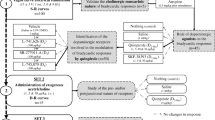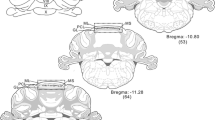Abstract
The cardiovascular responses to a series of selective histamine H3 receptor agonists, (R) α-methylhistamine, imetit and immepip and selective antagonists, thioperamide, clobenpropit and clophenpropit, were studied in anaesthetized rats. At 0.003–1 μmol/kg i.v. doses, H3 agonists failed to produce any significant change in the basal blood pressure and heart rate. Larger doses of (R) α-methylhistamine increased the blood pressure and heart rate and higher doses of imetit caused vasodepressor responses and reduced heart rate, whereas immepip proved virtually inactive. While (R) α-methylhistamine-induced effects were not blocked by histamine H1-, H2- and H3-receptor antagonists, they were however reduced by idazoxan and propranolol, which indicates that the mechanisms involved are adrenergic. The effects induced by imetit are not related to histamine H3 receptors but are mediated by indirect (via 5HT3 receptors) cholinergic mechanisms, since these effects were prevented by 1 mg/kg i.v. atropine and by 0.1 mg/kg i.v. ondansetron. Similarly, the H3 antagonists per se failed to change basal cardiovascular function up to 10 μmol/kg i.v. and only at 30 μmol/kg i.v. were marked decreases observed in the blood pressure and heart rate with a significant reduction in the effects of noradrenaline. These data indicate that in anaesthetized rats, histamine H3 receptor activation or blockade has no effect on basal cardiovascular function. The effects recorded after the administration of large doses of (R) α-methylhistamine and imetit are clearly unrelated to histamine H3 receptors and should be taken into account when using these compounds as H3 ligands for “in vivo” experiments.
Similar content being viewed by others
References
Arrang JM, Garbarg M, Schwartz JC (1983) Auto-inhibition of brain histamine release mediated by a novel class (H3) of histamine receptors. Nature 302:832–837
Barnes JC, Brown JD, Clarke NP, Clapham J, Evans DJ, Oshaughnessy CT (1993) Pharmacological activity of VUF 9153, an isothiourea histamine H3 receptor antagonist. Eur J Pharmacol 250:147–152
Berkowitz BA, Spector S, Tarver JH (1972) Resistance of noradrenaline in blood vessels to depletion by 6-hydroxydopamine or immunosympathectomy. Br J Pharmacol 44:10–16
Boudreau NI, Vohra MM (1991) The mechanism of [3H] noradrenaline release by histamine and its analogs from the rat vas deferens. Can J Physiol Pharmacol 69:469–474
Cambridge D (1981) UK 14,304 a potent and selective α2-agonist for the characterization of α-adrenoceptor subtypes. Eur J Pharmacol 72:413–415
Ea Kim L, Oudart N (1988) A highly potent and selective H3 agonist relaxes rabbit middle cerebral artery, in vitro. Eur J Pharmacol 150:393–396
Ea Kim L, Javellaud J, Oudart N (1992a) In vivo cardiovascular effects of histamine H3-agonist and H3-antagonist. Fundam Clin Pharmacol 6:206
Ea Kim L, Javellaud J, Oudart N (1992b) Endothelium-dependent relaxation of rabbit middle cerebral artery to a histamine H3 agonist is reduced by inhibitors of nitric oxide and prostacyclin synthesis. Br J Pharmacol 105:103–106
Ehinger B (1974) Uptake of histamine or histamine metabolites into sympathetic noradrenergic axons. Acta Physiol Scand 90:218–225
Ganellin CR, Bang-Andersen B, Khalaf YS, Tertiuk W, Arrang JM, Garbarg M, Ligneau X, Rouleau A, Schwartz JC (1992) Imetit and N-methylderivatives. The transition from potent agonist to antagonist at histamine H3 receptors. Bioorg Med Chem Lett 10:1231–1234
Garbarg M, Arrang JM, Rouleau A, Ligneau X, Dam Trung Tuong M, Schwartz JC, Ganellin CR (1992) S-2-(4-imidazolyl) ethyl isothiourea, a highly specific and potent histamine H3 receptor agonist. J Pharmacol Exp Ther 263:304–310
Hegde AA, Chan P, Eglen RM (1994) Cardiovascular effects of R-alpha-methylhistamine, a selective histamine H3 receptor agonist, in rats: lack of involvement of histamine H3 receptors. Eur J Pharmacol 251:43–51
Hey JA, Del Prado M, Egan RW, Kreutner W, Chapman RW (1992) Inhibition of sympathetic hypertensive responses in the guineapig by prejunctional histamine H3-receptors. Br J Pharmacol 107:347–351
Ishikawa, S, Sperelakis N (1987) A novel class (H3) of histamine receptors on perivascular nerve terminals. Nature 327: 158–160
Kathmann M, Schlicker E, Detzner M, Timmerman H (1993) Nordimaprit, homodimaprit, clobenpropit and imetit: affinities for H3 binding sites and potencies in a functional H3 receptor model. Naunyn-Schmiedeberg's Arch Pharmacol 348: 498–503
Kobinger W, Pichler L (1981) α1 and α2 adrenoceptor subtypes: selectivity of various agonists and relative distribution of receptors as determined in rats. Eur J Pharmacol 73: 313–321
Luo XX, Tan YH, Sheng BH (1991) Histamine H3-receptors inhibit sympathetic neurotransmission in guinea pig myocardium. Eur J Pharmacol 204:311–314
Luo XX, Tan YH, Sheng BH (1993) Histamine inhibits cardiac sympathetic neurotransmission by interacting with H3-subtype of histamine receptors. Asia Pac J Pharmacol 8:17–22
Malinowska B, Schlicker E (1991) H3 receptor-mediated inhibition of the neurogenic vasopressor response in pithed rats. Eur J Pharmacol 205:307–310
Malinowska B, Schlicker E (1993) Identification of endothelial H1, vascular H2 and cardiac presynaptic H3 receptors in the pithed rat. Naunyn-Schmiedeberg's Arch Pharmacol 347:55–60
McLeod RL, Gertner SB, Hey JA (1991) Modulation of cardiovascular function by central histamine H3 receptors in conscious guinea pigs. Eur J Pharmacol 206:141–142
McLeod RL, Gertner SB, Hey JA (1993) Production by R-alphamethylhistamine of a histamine H3 receptor-mediated decrease in basal vascular resistance in guinea-pigs. Br J Pharmacol 110:553–558
McLeod RL, Gertner SB, Hey JA (1994) Species difference in the cardiovascular responses to histamine H3 receptor activation. Eur J Pharmacol 259:211–214
Rosic M, Collis CS, Andjelkovic IZ, Segal MB, Djuric D, Zlokovic BV (1991) The effects of (R)α-methylhistamine on the isolated guinea pig aorta. In: Timmerman H, van der Goot H (eds) New perspectives in histamine research. Birkhäuser, Basel, pp 283–287
Ruffolo RR, Waddell JE, Yaden EL (1981) Postsynaptic alpha adrenergic receptor subtypes differentiated by yohimbine in tissues from the rat. Existence of alpha-2 adrenergic receptors in rat aorta. J Pharmacol Exp Ther 217:235–240
Schlicker E, Malinowska B, Kathmann M, Gothert M (1994) Modulation of neurotransmitter release via histamine H3 heteroreceptors. Fund Clin Pharmacol 8:128–137
Schwartz JC, Arrang JM, Garbarg M, Pollard H (1990) A third histamine receptor subtype: characterization, localization and function of H3 receptors. Agents Actions 30:13–23
Shore PA (1962) Release of serotonin and catecholamines by drugs. Pharmacol Rev 14:531–550
Thoenen H, Tranzer JP (1968) Chemical sympathectomy by selective destruction of adrenergic nerve endings with 6-hydroxydopamine. Naunyn-Schmiedeberg's Arch Pharmak Exp Pathol 261:271–288
van der Goot H, Schepers MJP, Sterk GJ, Timmerman H (1992) Isothiourea analogues of histamine as potent agonists or antagonists of the histamine H3 receptor. Eur J Med Chem 27: 511–517
Vollinga RC, De Koning JP, Jansen FP, Leurs R, Menge WMPB, Timmerman H (1994) A new potent and selective histamine H3 receptor agonist, 4-(1H-Imidazol-4-ylmethyl-piperidine). J Med Chem 37:332–333
Author information
Authors and Affiliations
Rights and permissions
About this article
Cite this article
Coruzzi, G., Gambarelli, E., Bertaccini, G. et al. Cardiovascular effects of selective agonists and antagonists of histamine H3 receptors in the anaesthetized rat. Naunyn-Schmiedeberg's Arch Pharmacol 351, 569–575 (1995). https://doi.org/10.1007/BF00170155
Received:
Accepted:
Issue Date:
DOI: https://doi.org/10.1007/BF00170155




